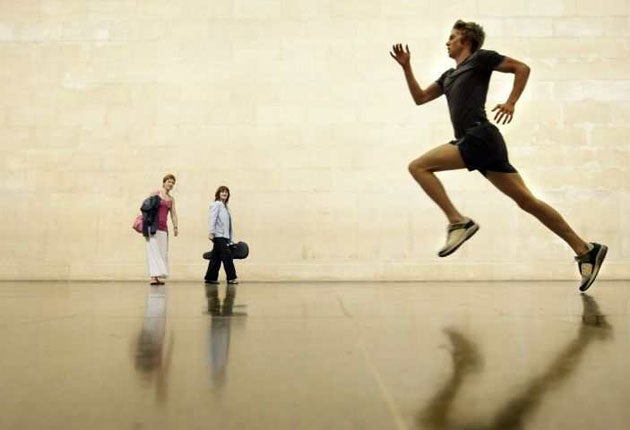Visual Art in 2008: How the Tate was given a good run for its money
Abstraction rose from the grave, but the art world has lost the man who created the blank canvas

I never thought I'd write these words, but the best piece of art I saw in 2008 was conceptual. Martin Creed's Work No 850, popularly known as "The Tate Sprinters", saw a sequence of athletes pounding down the Duveen Galleries' marbled halls at one-minute intervals from July to November, their hell-for-leather dash turned from heroism to pathos by the sheer vastness of the space. It was heart-stopping.
For me, Work No 850 has changed Tate Britain for ever: I'll never go there again without hearing the spectral footfalls of Creed's runners, waiting for them to speed past, strong and intent, Attic and frail. And what is art for if not transformation?
Turkey of the year
Turkeys being American, mine is the judgement handed down by Judge Stanley Ott who, in May, dismissed a petition in a Pennsylvania court to stop the Barnes Foundation from being moved. Founded in 1922 by an irascible medic of that name, the Barnes is pure magic – a suburban neo-Renaissance villa full of Picassos and Cézannes, with a site-specific mural, La Danse, by Matisse. It is one man's vision, a relic of his generosity and passion. But Philadelphia's porkbarrel politicians have decided, in the abused name of "accessibility", that Dr Barnes's collection should be shifted to a soulless new building on a city centre highway. If it goes ahead, the move will constitute one of the greatest acts of cultural vandalism in American history. Join the protest at www.barnesfriends.org.
Face of the year
Not, oddly, a new face but an old one – Sir Norman Rosenthal, who retired from the Royal Academy in January after 31 years spent organising its exhibitions. Often loathed, occasionally loved, sometimes punched on the nose, the pugnacious Rosenthal took the RA from a musty club for shires painters to the international art hotspot it is today. While putting on such classical biggies as The Genius of Rome in 2003, the outgoing head of exhibitions also showcased new work – most famously, that of the Young British Artists in Sensation in 1997. As a result, Royal Academicians now number Gary Hume and Tracey Emin in their ranks. But for Rosenthal there might not be an RA today: on which grounds alone, Hail, Sir Norman, and farewell.
Newcomer of the year
Tomma Abts' 2006 Turner Prize win was a sign that abstraction was not quite gone from the earth, and an exhibition in June by a young German-Italian artist, Esther Stocker, was another. What I Don't Know About Space at Museum 52 was her London debut. Using nothing but genius and black sticky-tape, Stocker turned the gallery into something between a 3-D Bridget Riley and an inside-out Daniel Buren. Stocker's games of space and line were mesmerising. They were also strangely funny, as though the pinstripe-order of British society had suddenly come unstuck. Every now and then, you despair that old-fashioned formalism has disappeared beneath the dead hand of concept. And then a wonder like Stocker comes along to prove you wrong. Hurrah.
R.I.P.
Robert Rauschenberg, who died in May at the age of 82. Long before the Chapmans were drawing red noses on Goyas – before they were twinkles in Mrs Chapman's eye, in fact – Rauschenberg was rubbing out a de Kooning drawing to produce Erased de Kooning (1953). His Combines of the early 1950s paved the way for modern installation art by cultifying mounds of trash; his 1951 show of blank white canvases led one abstract expressionist to snap, "If this is modern art, I quit." If Rauschenberg himself peaked too early – his best work was done by 1960 – his willingness to embrace the peripheral and scabrous made him the greatest artistic influence on the generations that have followed: it is hard to imagine most of the YBAs without a Rauschenberg having existed. "Screwing things up is a virtue," he said. "Being right is never the point". Gor' bless 'im, one and all.
Join our commenting forum
Join thought-provoking conversations, follow other Independent readers and see their replies
Comments